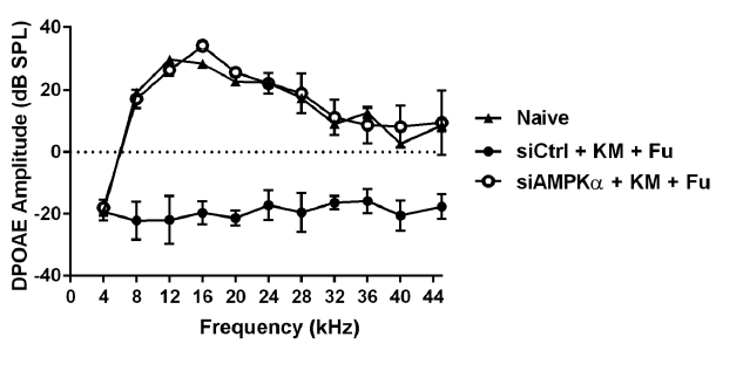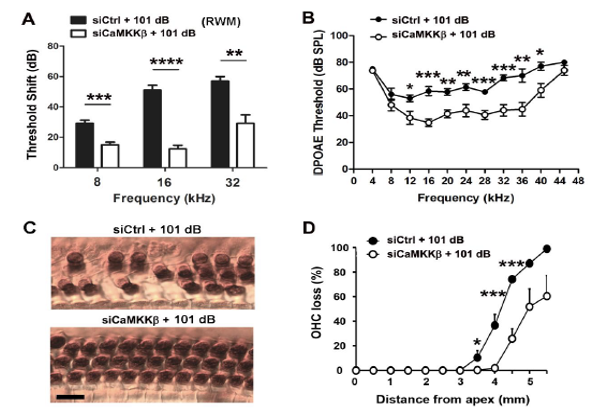Description:
Compositions and Methods for Attenuation of Hearing Loss
Technology: Researchers at MUSC have developed a biopharmaceutical therapy that reduces the expression of specific proteins associated with both noise and chemically induced hearing loss. The invention provides a gene therapy and therapeutic target for prevention of acquired hearing loss. Previous studies by the researchers had shown that levels of phosphorylated AMPKα increased in hair cells in a noise intensity-dependent manner and correlated with increasing loss of outer hair cells, and that the inhibition of AMPK via siRNA or a pharmacological inhibitor prevented this loss.1 Recently, MUSC researchers have expanded upon these efforts revealing two important advancements:
1. The inhibition of AMPK via siRNA or a pharmacological inhibitor can also attenuate chemically induced hearing loss (Figure 1); and
2. The inhibition of the upstream activator of AMPK, Ca2+/calmodulin-dependent protein kinase kinases (CaMKKs), can attenuate both noise induced and chemically induced hearing loss (Figure 2).
Extending their findings on the involvement of AMPK in noise induced hearing loss, the researchers further found that activation of AMPKα is involved in aminoglycoside-induced hearing loss and sought inhibit AMPKα. It was found that the inhibition of AMPK was successful in preventing chemically induced hearing loss (Figure 1).

Figure 1. Delivery of AMPKα siRNA via PSC application completely prevents KM-furosemide-induced damage to OHC function measured by DPOAE 14 d after the injection.
In addition to the effects on AMPK, noise exposure and kanamycin (simulating chemically induced hearing loss) exposure was found to increase the expression of the CaMKKβ isomer. By introducing the small interfering CAMKKβ siRNA (siCaMKKβ), CaMKKβ expression was reduced in OHCs and significantly attenuated noise-induced losses of synapses and OHCs and NIHL in adult CBA/J mice at the age of 12 weeks (Figure 2).

Figure 2. Pretreatment with CaMKKβ siRNA via intra-tympanic delivery on RWM reduces NIHL assessed 14 d after noise exposure. (A) Pretreatment with siCaMKKβ significantly decreases threshold shifts induced by exposure to 101-dB noise at 8, 16, and 32 kHz. (B) Pretreatment with siCaMKKβ significantly attenuates 101-dB-noise-increased DPOAE thresholds from 12–40 kHz (C) Representative images revealed Myosin-VIIA-immunolabeled OHCs (brown) 14 d after 101-dB-noise exposure in groups pretreated with siControl or siCaMKKβ. (D) Quantification of OHC numbers along the cochlear duct showed that pretreatment with siCaMKKβ significantly reduced noise-induced OHC loss.
Overview: Deafness is the number-one disability in the US, with hearing loss affecting more than 35 million individuals. The common pathology of acquired hearing loss is loss of cochlear sensory hair cells with outer hair cells (OHCs) being more sensitive than inner hair cells (IHCs). This common pathology has been well documented both in humans and in animal models. Since cochlear sensory hair cells in mammals do not regenerate, the loss is irreversible and causes permanent hearing loss. Currently, there are no clinical therapies for prevention and treatment of acquired hearing loss. Biopharmaceutical therapy by small interfering RNA (siRNA), small hairpin RNA (shRNA), and microRNA (miRNA) has gained tremendous attention in the therapeutic landscape, which is why the discussed invention is favorable.
Applications: Hearing loss prevention, biopharmaceutical therapy, drug delivery,
Advantages:
Prevention of hearing loss – Can prevent hearing loss once it begins to onset
Multiple potential targets – Therapies targeting multiple targets including AMPK and CAMKK
Multiple indications – Applications in noise induced and chemically induced hearing losses
Key Words: deafness, hearing Loss, protein, signaling, biopharmaceutical, therapy
Inventors: Su-Hua Sha
Patent Status: PCT/US2020/063478 filed 12/4/20 -under review at patent office.
MUSC-FRD Technology ID: P20031 and P20041
References: [1] Hill K., Yuan H., Wang X., Sha S., “Noise-Induced Loss of Hair Cells and Cochlear Synaptopathy Are Mediated by the Activation of AMPK.” The Journal of Neuroscience, 36(28):7497–7510 (2016).